 Deutsche Version
Deutsche VersionOn this page you can read which digital camera I used at the time. There's also a short feedback to each model.
My first digital camera, bought in summer sale. It has a fixed lens,
so no zoom! Data storage is very universal, the camera has a PCMCIA
slot that can be used for compact flash cards with adapter.
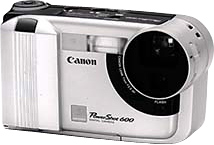
The highest consecutive number of photos taken with this camera
resulted from
the summer
holidays in Finnland,
1998. I borrowed a PCMCIA harddrive
(340MB)
and took more than 500 photos.
Accessories bought over time: Canon camera bag, 64MB ATA-flash card
(Kingmax),
8MB
compact flash (Kingmax) and PCMCIA adapter (Canon). The PCMCIA adapter
is the
only
thing
that I kept when I sold the camera in 2000.
Conclusion:
The camera proved quite good over almost three years.
I don't know exactly how many photos with it, but it were over 2500.
The camera
never experienced technical defects, but all the noname memory cards
did! They
all failed over time, which teached me for the future.
Good points were back in 1998: The resolution (well, times changed...),
the universal
storage media, the optical viewfinder and price. Weak points were of
course the
fixed lens, the very slow autofocus, the shutter delay, the weak
battery and
the size for it's tiny range of functions.
Technical data:
| Resolution | 832*608 (ca 0.5M pixel) |
| Lens | 7mm f/2.5 (corresponds to 50mm in the common 35mm format) |
| Sensitivity | ISO 100 |
| Storage media | PCMCIA slot for ATA flash / harddrive / compact flash (with adapter) |
| Power supply | Dedicated Ni-Cd Battery / six AA alkaline batteries (with adapter) |
| Dimensions | 159.5 x 92.5 x 58.8 mm |
| Weight | 420g |
| Image size | 100kb (JPG) |
| Buying price (1998) | approx. 650 CHF |
| Link: | Page in the Canon Camera Museum |
The budget for the 2nd camera was bigger. But the camera had to be
smaller and the target was 3M pixel resolution. After a short time I
found "my" camera at the photo store that my father frequents: Photo Video
Zumstein, Bern. After my experience with the Powershot 600 and
because of the simple handling I decided again for the Canon:
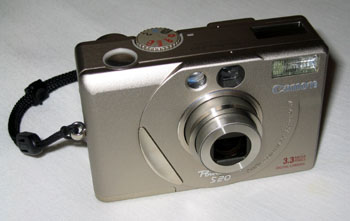
The camera was really a huge improvement over the Powershot 600. The
resolution
seemed huge and was enough for A4 page filling prints if the photo was
good.
New to me was the zoom lens which I appreciated immediately. The TFT
display
as viewfinder was new, too. A very practical but battery killing
feature.
The definitely biggest project with this camera was the Goodwood
Festival of
Speed 2002. In just three days I took about 350 photos, most of
them using
my brother's 512MB Microdrive. There could be even more photos, if the
batteries
lasted longer...
Accessories bought over time: Canon camera bag, 64MB compact flash card
(Sandisk!),
2nd battery. Later: Two 128MB compact flash cards (Kingston, Sandisk).
Of course
I bought a Sandisk image mate USB cardreader shortly after the camera!
I sold everything except the two 128MB cards and the cardreader in
November 2003.
Conclusion:
The camera proved very, very well over almost three years!
In total, I took between 3000 and 3500 photos with this little camera.
It never
experienced technical defects, it proved to be very robust in its
camera bag.
Because of its tiny dimensions, I took the camera with me anywhere:
Ski-run,
scouting, motorbike tours, mountain tour, car racing, all holidays. The
only
pocket where the camera doesn't fit in is the pocket of the swimming
trunks;
that's OK because the camera is just about spash-proof. The camera
didn't refuse
operating (not even when it experienced a lot of condensation water),
it ever
ran if the battery provided enough energy.
Good points: Dimensions, weight, robustness, storage media (Microdrive
compatible),
Resolution (exceptional in year 2000), quickness, little shutter delay,
simple
handling, good picture quality. The resolution, which is 2* SGXA
indeed, proved
to be very handy, too.
Weak points: Battery and battery (I had two of them...). Noise with
high ISO
values, tiny 2x zoom, no manual white balance. Everything but the
feeble
batteries isn't a big issue. Only 50 photos average per battery isn't
enough!
Fully charged, I took by chance 130 photos per battery, the Microdrive
didn't
perform as well with just 50 photos per battery. Canon learned
something and
only uses Li-Ion batteries prior to the successor model.
Technical data:
| Resolution | 2048*1536 (3M pixel) |
| Lens | 6.5-13mm f/2.9-4.0 (corresponds to 32-64mm in 35mm format) |
| Sensitivy | ISO 100. ISO 200/400 with signal gain. |
| Storage media | Compact flash type I und II (Microdrive compatible) |
| Power supply | Ni-MH rechargeable battery |
| Display | 1.8" TFT |
| Dimensions | 105.4 x 69.4 x 33.8 mm |
| Weight | 270g |
| Image size | 1MB (JPG) |
| Buying price (2000) | 1400 CHF |
| Link: | Page in the Canon Camera Museum |
Because of the little adjusting possibilities and because of the
missing telezoom of the Powershot S20 I began to look for a better
camera in spring 2003. The Canon Powershot G3 and G5 were my favourites
for some time, but when Canon announced the EOS 300D I knew that would
be my next digital camera.
I could finally pick up the EOS 300D (called "Digital Rebel" in the
USA) in November 2003, of course again at Photo Video
Zumstein in Bern.
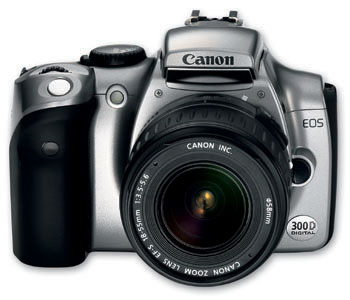
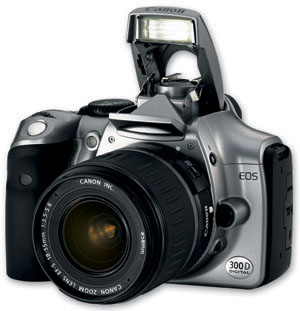
Obviously this digital reflex camera is on a completely different level
than a compact camera. The big image sensor takes photos with little
noise even with low light condidtions and high ISO values. The canon EF
lens bayonet introduces you in a giant world of Canon lenses from cheap
novice lenses up to priceless professional cannons. The autofocus isn't
driven by a slow digital CCD chip but by quick specialized electronics,
as usual for reflex cameras. Mirror and shutter principle make it
impossible to use the display as viewfinder.
Very useful are the extremely quick autofocus, the near to nothing
shutter delay, the instant ready feature (short delay after power-on),
the good zoom range of 24-88mm even with the kit lens and last but not
least the very powerful battery. All this for a price that you have
dreamed for not long ago.
Because of the smaller image sensor, there is a "crop factor" of 1.6 in
comparison to a standard 35mm reflex camera. That means that the focal
lenght of a standard
lens will be virtually "extended" by factor 1.6.
Conclusion:
I had this camera only one year. Not
because it was bad, absolutely not. It started a process in me that
demands for
more! The EOS 300D was and is a very good camera to enter the world of
digital
single lens reflect cameras. You learn quickly which aperture and which
shutter
time is about right. That's exactly what I bought the EOS 300D for -
target achieved.
I never had problems with this camera, not a single one. The battery
lifetime
deserves a very positive note. And of course the image quality, it's
absolutely
stunning even with high ISO values. I can't find any negative things, I
was aware
of some missing features when I bought the camera.
Accessories:
512+128MB compact flash cards (Sandisk, Kingston)
Sandisk Imagemate USB card reader
Flash: Metz 54MZ-3
2nd Battery
Lenses:
View lenses und accessoires.
Technical data:
| Resolution | 3072*2048 (6M pixel). Notice the classic 3/2 aspect ratio! |
| Sensor | CMOS sensor, 22.7mm x 15.1mm |
| Sensitivy | ISO 100-1600 |
| Storage media | Compact flash type I and II (Microdrive compatible) |
| Power supply | Li-Ion rechargeable battery (approx. 500 photos!) |
| Display | 1.8" TFT, ca 118000 pixel |
| Dimensions | 142 x 99 x 72.4 mm |
| Weight | 560g (body only) |
| Image size | 1.8-3MB (JPG) / 7MB (RAW) |
| Buying price (2003) | 1899 CHF (kit with body and standard zoom) |
| Link: | Canon website, Review at Digital Photography Review (Englisch), DSLR Forum (German) |
The EOS 300D was a fantastic camera. But there was an important
feature missing for sports photography: Servo AF. Of course it had the
Servo AF, but it was only active in the Sport preset. And not
switchable in the more interesting "P, Tv, Av, M" programs. When Canon
announced the 20D about one year after the 300D, my choice was clear
immediately. End of September I saw one at my favourite shop Foto Video Zumstein
and immediately traded in my EOS 300D body to get the 20D.
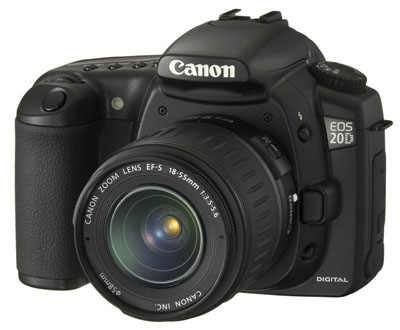
The EOS 20D is the successor of the EOS 10D, thus a semi professional
camera. The most important improvements: New sensor at 8M pixel, Digic
II signal processor, faster contignous shooting (5 frames per second),
better autofocus system with 9 AF points, remarkably shorter power-on
delay, faster CF interface, improved flash E-TTL II, EF-S bajonet.
Compared to the 300D, there is the new "pro" concept with two wheels
and the custom functions.
Much rests the same - including the 1.6 crop factor. I kept all lenses
including the kit lens of the 300D. The only "problem" so far was a
very dirty sensor right out of the box (cleaned on warranty).
I sold the Metz flash because I was not satisfied with it on the 20D.
It was replaced by a Canon Speedlite 550EX which seems to work better
with E-TTL II.
Up to now, the camera and the lenses perform excellent. Robust,
reliable, fast and easy to use.
Problems:
Well, there weren't really much if any! The camera has been working fine for 8 years. 2012 the trigger button began to release with a delay or didn't release at all.
Workaround: Camera shutter contact problem repair in 1 min
Canon Switzerland (or rather their professional service partner) refused to send me the necessary parts for definitive repair. I ended up buying the parts in the US when I was in California.
Accessories:
Memory: SanDisk Compact Flash cards
SanDisk USB 2.0 card reader
3x Batteries (noname/Sanyo)
Lenses:
View lenses und accessoires.
Technical data:
| Resolution | 3504*2336 (8M pixel). Notice the classic 3/2 aspect ratio! |
| Sensor | CMOS sensor, 22.5mm x 15mm |
| Sensitivy | ISO 100-3200 |
| Storage media | Compact flash type I und II (Microdrive compatible) |
| Power supply | Li-Ion rechargeable battery (approx. 600 photos!) |
| Display | 1.8" TFT, ca 118000 Pixel |
| Dimensions | 144 x 106 x 72 mm |
| Weight | 770g (body only) |
| Image size | 2.5-4MB (JPG) / 9MB (RAW) |
| Buying price (2004) | 2470 CHF (body only) |
| Link: | Canon webseite, article at Digital Photography Review, DForum (German) |
Starting with the EOS 300D, I began to buy some lenses and accessoires for the Canon EF bajonet. Of course these are not bound to a camera.
Lenses:
Canon EF 17-40 f/4.0 USM wide angle zoom.
Canon EF-S 18-55 f/3.5-5.6 kit lens.
Canon EF 50 II f/1.8 als fast portrait lens.
Canon EF 100 f/2.0 USM the fast tele lens
for indoor sports or portraits.
Canon EF 70-200L f/4.0 USM telezoom.
Canon EF 300L f/4.0 IS USM tele with
optical image stabilisator.
Canon 1.4x Extender.
Accessoires:
Flash: Canon Speedlite 550EX
Remote shutter
Bags: Lowepro Top Load Zoom 1, Top Load Zoom
Backpack: Lowepro Minitrekker Classic
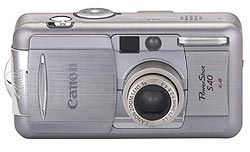
As an addition to the SLR, I bought this used Canon Powershot S40. It was mainly
used on holidays where the SLR didn't fit into the luggage. Cheap, easy
to use, nothing special.
Technical data: 3M Pixel, CF Interface
The camera got its age and was thus replaced by the Lumix in 2011.
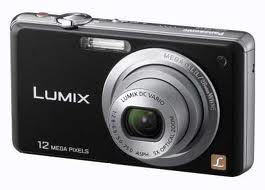
The Lumix is a very small camera that fits in the pocket. Why not Canon any more? Well, the Lumix is simply the better offer for the same price. And I was really fed up with very short battery life on all my small Canons so far. I like about the Lumix: Long battery life, big display, very easy to use. In summary an excellent camera for little money.
Technical data: 12M Pixel, SDHC card
back to the photo main page.